You are using an out of date browser. It may not display this or other websites correctly.
You should upgrade or use an alternative browser.
You should upgrade or use an alternative browser.
Eurofighter Typhoon
- Thread starter Scorpion82
- Start date
- Joined
- 3 June 2006
- Messages
- 3,094
- Reaction score
- 3,966
Yeah, the Eurofighter Typhoon is having a boob job.  ;D
;D
"Eurofighter Typhoon in new, special Tiger Livery is freaking awesome"
Jun 05 2014
By David Cenciotti
Source:
https://www.facebook.com/BavarianTigersNeuburg?fref=photo
Jun 05 2014
By David Cenciotti
Source:
https://www.facebook.com/BavarianTigersNeuburg?fref=photo
Ahead of the Tiger Meet later this month, Bavarian Tigers have unveiled the very first Eurofighter Typhoon in complete Tiger livery.
NATO Tiger Meet (NTM) is an annual multinational exercise that gathers squadrons sporting Tiger (or feline) emblems. Among the highlights of the meeting, is the fact that combat planes and helicopters often sport spectacular color schemes, making the event a treat for all aviation enthusiasts.
Bavarian Tigers, founded on Mar. 18, 2013, by the 741 and 742 squadrons of the German Air Force’s Jagdgeschwader 74 in Neuburg, that took over the Tiger Spirit from the 321 Squadron / Jagdbombergeschwader 32, will take part to this year’s NTM (with spotters days on Jun. 19 and 23) at Schleswig – Jagel, in northern Germany.
To celebrate the attendance to the NTM2014, the Fighterwing 74 has painted one of its Eurofighters with an awesome, flamboyant tiger outfit.
Image credit: Bavarian Tigers/German Air Force
Let’s hope the cool paint job will survive at least for some mission: last year, one of the Polish Air Force F-16 Block 52+ was given a special paint, most of which, unfortunately, peeled away during the ferry flight to Orland, Norway, that hosted the NTM2013.
Attachments
-
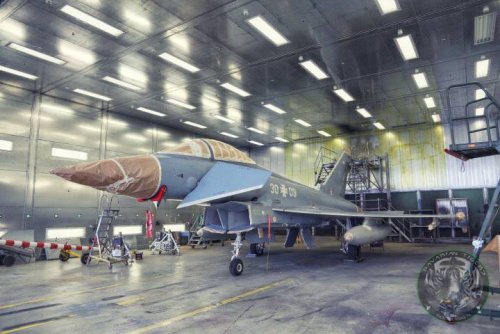 10352343_634036863354518_5649090653662361804_n.jpg57.9 KB · Views: 627
10352343_634036863354518_5649090653662361804_n.jpg57.9 KB · Views: 627 -
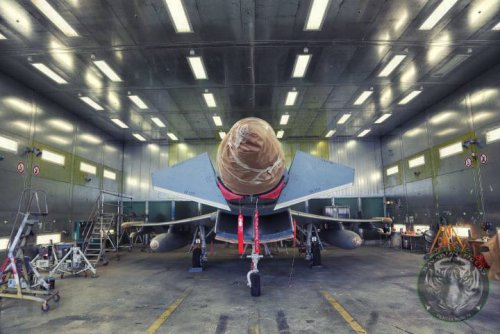 10175066_634036880021183_5854110566499601547_n.jpg54.9 KB · Views: 595
10175066_634036880021183_5854110566499601547_n.jpg54.9 KB · Views: 595 -
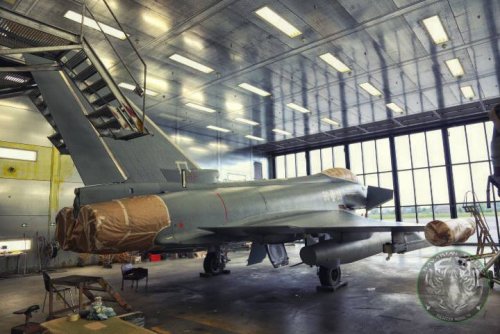 10361412_634036876687850_4898550945970437092_n.jpg59.7 KB · Views: 586
10361412_634036876687850_4898550945970437092_n.jpg59.7 KB · Views: 586 -
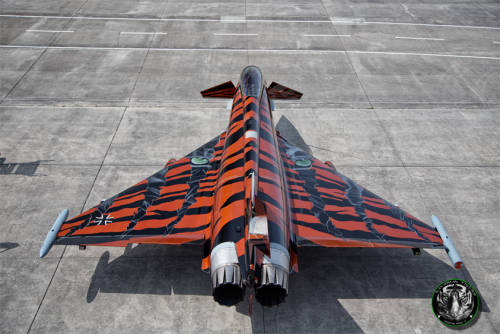 Bavarian-Typhoon-special.png849.8 KB · Views: 585
Bavarian-Typhoon-special.png849.8 KB · Views: 585 -
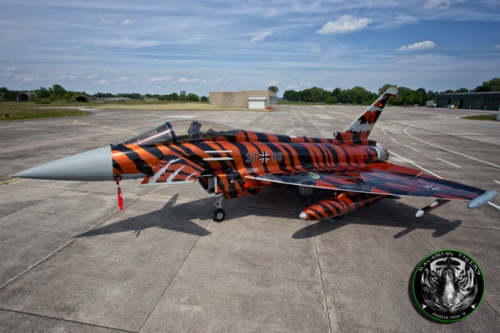 Bavarian-Typhoon1-685x456.png529.7 KB · Views: 510
Bavarian-Typhoon1-685x456.png529.7 KB · Views: 510 -
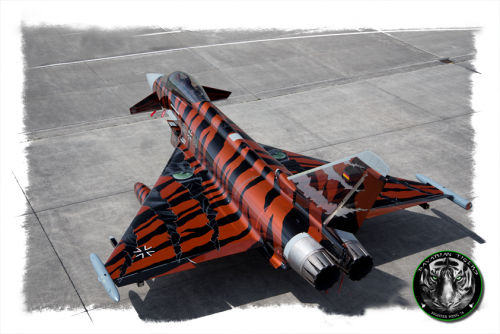 10431454_644950892263115_8822271912485225961_n.png650.1 KB · Views: 176
10431454_644950892263115_8822271912485225961_n.png650.1 KB · Views: 176
Wicked! 
Maury Markowitz
From the Great White North!
- Joined
- 27 February 2014
- Messages
- 192
- Reaction score
- 144
To be perfectly honest, I'm on the wrong side of the pond to really know the Typhoon very well. It appears to represent the pinnacle of development of a line of improvement stretching to the late 1960s when maneuverability and actual fighting once again became considered important. The F-35, on the other hand, seems to be a return to a slightly older concept, the "missileer". Perhaps technology has made that possible today, I don't really know.
But what I do know is that Canada's planned replacement for the F-18 is looking increasingly worrying. The current airframes have houred-out and are now appearing at museums more often than air shows. So if the F-35 does implode, I'd like to understand what options the RCAF might have.
The F-18E would have advantages in terms of commonality, but from everything I've read and heard that aircraft is a turkey. So, the Typhoon. Reading over summaries, especially on the Wiki, it seems this project had many problems of its own. But it is flying now, although it seems to be in a limited capacity. An immediate upgrade in the form of an AESA is available, which changes things slightly. So:
1) is the Typhoon now gaining air-to-ground capacity? it seems this is a serious limitation, or was anyway
2) what does the AESA unit do to costs?
3) is there any comparison F-18 vs. Typhoon? It seems the Typhoon outperforms in almost all "fighter like" ways, but I'm not sure that's cogent any more.
But what I do know is that Canada's planned replacement for the F-18 is looking increasingly worrying. The current airframes have houred-out and are now appearing at museums more often than air shows. So if the F-35 does implode, I'd like to understand what options the RCAF might have.
The F-18E would have advantages in terms of commonality, but from everything I've read and heard that aircraft is a turkey. So, the Typhoon. Reading over summaries, especially on the Wiki, it seems this project had many problems of its own. But it is flying now, although it seems to be in a limited capacity. An immediate upgrade in the form of an AESA is available, which changes things slightly. So:
1) is the Typhoon now gaining air-to-ground capacity? it seems this is a serious limitation, or was anyway
2) what does the AESA unit do to costs?
3) is there any comparison F-18 vs. Typhoon? It seems the Typhoon outperforms in almost all "fighter like" ways, but I'm not sure that's cogent any more.
- Joined
- 27 December 2005
- Messages
- 17,752
- Reaction score
- 26,438
If you don't mention F-35 we may get away with comparing the Typhoon and F-18.
- Joined
- 3 June 2011
- Messages
- 18,340
- Reaction score
- 12,245
PaulMM (Overscan) said:If you don't mention F-35 we may get away with comparing the Typhoon and F-18.
Speaking of, I always thought the canard-equipped Hornet 2000 concept was interesting. I wonder if it would have had more get up and go than the eventual Super Hornet.
PaulMM (Overscan) said:If you don't mention F-35 ....
Insert Basil Fawlty reference HERE.
donnage99
ACCESS: Top Secret
- Joined
- 16 June 2008
- Messages
- 1,355
- Reaction score
- 870
I know Ausairpower has massive bias against the f-35 that it often tainted their analysis relating to the program. However, it doesn't change the fact that they do have great articles on there about other things.
This article is one of them:
http://www.ausairpower.net/Analysis-Typhoon.html
This article is one of them:
http://www.ausairpower.net/Analysis-Typhoon.html
phrenzy
as long as all they ask me about is the air war...
- Joined
- 31 October 2013
- Messages
- 271
- Reaction score
- 21
I think Canada needs to (and really they clearly have though they might have drawn incorrect conclusions) make up its mind what it's going to use it's fighters for.
For NORAD continental defence the Typhoon probably isn't a bad choice. It's not like the Canadians are likely to need much penetration/strike capability over heavy A3D areas, we are talking about Canada here.
But because of the integrated air defence network, Canada more than most of the other countries that use the argument, really does have a reason for interoperability with US forces. It would be much simpler for the Cheyenne mountain crew to scramble f-35s wherever they are and whoever they belong to than having to worry about other airframes and their capabilities (not just performance but weapons/datalinks etc).
I know that former defence officials are publicly very loud about Canada needing a twin engined jet. F-35 proponents say that new super duper engines mean that MTBF means that the lightning is going to be just as reliable but that's a VERY big claim for a plane that can't fly an 8 hour ferry mission over the Atlantic at the moment but time may bare them out.
All three are very different though I'm sure world history will not be significantly impacted regardless of whether Canada ends up with either Typhoons, Lightnings or super bugs.
Of course the Canadian choice is made and it's pretty damn likely that F-35 is happening regardless of how good it might or might not be in the fullness of time. Of course if it turns out to be a dog the US can afford to launch a skim milk sixth generation fighter program (ala 2018 bomber), Canada however will be stuck with its buy (as will Australia and other small buyers).
For NORAD continental defence the Typhoon probably isn't a bad choice. It's not like the Canadians are likely to need much penetration/strike capability over heavy A3D areas, we are talking about Canada here.
But because of the integrated air defence network, Canada more than most of the other countries that use the argument, really does have a reason for interoperability with US forces. It would be much simpler for the Cheyenne mountain crew to scramble f-35s wherever they are and whoever they belong to than having to worry about other airframes and their capabilities (not just performance but weapons/datalinks etc).
I know that former defence officials are publicly very loud about Canada needing a twin engined jet. F-35 proponents say that new super duper engines mean that MTBF means that the lightning is going to be just as reliable but that's a VERY big claim for a plane that can't fly an 8 hour ferry mission over the Atlantic at the moment but time may bare them out.
All three are very different though I'm sure world history will not be significantly impacted regardless of whether Canada ends up with either Typhoons, Lightnings or super bugs.
Of course the Canadian choice is made and it's pretty damn likely that F-35 is happening regardless of how good it might or might not be in the fullness of time. Of course if it turns out to be a dog the US can afford to launch a skim milk sixth generation fighter program (ala 2018 bomber), Canada however will be stuck with its buy (as will Australia and other small buyers).
- Joined
- 3 June 2011
- Messages
- 18,340
- Reaction score
- 12,245
phrenzy said:I think Canada needs to (and really they clearly have though they might have drawn incorrect conclusions) make up its mind what it's going to use it's fighters for.
For NORAD continental defence the Typhoon probably isn't a bad choice. It's not like the Canadians are likely to need much penetration/strike capability over heavy A3D areas, we are talking about Canada here.
If they're operating in support of NATO they certainly could be. Just take a look at what the current force has done.
- Joined
- 21 April 2009
- Messages
- 13,759
- Reaction score
- 7,700
sferrin said:phrenzy said:I think Canada needs to (and really they clearly have though they might have drawn incorrect conclusions) make up its mind what it's going to use it's fighters for.
For NORAD continental defence the Typhoon probably isn't a bad choice. It's not like the Canadians are likely to need much penetration/strike capability over heavy A3D areas, we are talking about Canada here.
If they're operating in support of NATO they certainly could be. Just take a look at what the current force has done.
All about the future and working along side US and NATO allies plus of course having a Gen 5 stealth aircraft.
Avimimus
ACCESS: Top Secret
- Joined
- 15 December 2007
- Messages
- 2,427
- Reaction score
- 909
Yes, being auxiliaries for the great armies of the United States requires having similar equipment...
I think many of the benefits of the F-35 are seen most in a highly networked environment with a large number of advanced allied aircraft. So, I don't see a country with a small number of them (like Canada) being able to deploy separately wihtout proper support elements. This limits geo-political flexibility and independence. The upside is that it requires a multilateral approach - which might be a good thing anyway.
What Canada needs is an interesting question indeed - might be fun to set up a topic to discuss this separately. I see you guys picked up on the engine reliability issue - it is true that Canada has had very bad experiences trying to use single engined fighters, and a lot of us have a culture that values the twin-engined requirement as much as the Russian's do with their Siberian interceptors...
In this respect the F-18 and the Eurofighter are both winners (while the LCA, JSF and Gripen tend to be viewed as F-86 replacements )
)
I think many of the benefits of the F-35 are seen most in a highly networked environment with a large number of advanced allied aircraft. So, I don't see a country with a small number of them (like Canada) being able to deploy separately wihtout proper support elements. This limits geo-political flexibility and independence. The upside is that it requires a multilateral approach - which might be a good thing anyway.
What Canada needs is an interesting question indeed - might be fun to set up a topic to discuss this separately. I see you guys picked up on the engine reliability issue - it is true that Canada has had very bad experiences trying to use single engined fighters, and a lot of us have a culture that values the twin-engined requirement as much as the Russian's do with their Siberian interceptors...
In this respect the F-18 and the Eurofighter are both winners (while the LCA, JSF and Gripen tend to be viewed as F-86 replacements
- Joined
- 17 October 2006
- Messages
- 2,393
- Reaction score
- 1,197
Turning to the original question (or two): The EF and SH have about the same installed thrust but were designed to do different things.
EF was mainly aimed at air combat in Central Europe and North Sea/Atlantic, and was consequently biased towards upper-right-hand performance: supercruise, supersonic maneuver and altitude. However, the idea was that the things that made that possible (low wing loading, high T/W, AAMs not occupying pylons) would also permit the jet to be loaded with fuel and iron for mud-moving missions.
The SH evolved from the Classic, which had been procured as a strike fighter and was based on 1970s technology, where transonic agility was given precedence over top-end speed, and of course it has to operate in the carrier environment. It is therefore slower and heavier than the Typhoon.
However, while the EF nations have taken an unconscionably long time to get their act together and realize the jet's multi-role potential (three of its sponsors have Tornados for A-G) the USN has invested a lot in the SH, steadily and consistently. As it stands today it is more versatile than the Typhoon. However, the Euros seem to have finally gotten the message, hence the work on AESA, Storm Shadow &c.
The SH is probably going to cost less than the EF, both to acquire and to operate.
However, it is entirely correct that Canada has to formulate its requirement from the ground up: What targets do you want to hold at risk, and where? What threats will you face? Relatively, how important is each mission that you identify? Next stage: what aircraft/weapon combinations are out there, how effective are they and what do they cost?
Until a nation has done that, its military and civilian leaders can't say that they have chosen the best balance of capability and cost, because they have not done the necessary homework, any more than you can say that you bought the right car when you only read about BMWs and only visited the BMW dealership.
As for the canard F-18: I never got the impression that it made it very far beyond the back-of-the-envelope stage.
EF was mainly aimed at air combat in Central Europe and North Sea/Atlantic, and was consequently biased towards upper-right-hand performance: supercruise, supersonic maneuver and altitude. However, the idea was that the things that made that possible (low wing loading, high T/W, AAMs not occupying pylons) would also permit the jet to be loaded with fuel and iron for mud-moving missions.
The SH evolved from the Classic, which had been procured as a strike fighter and was based on 1970s technology, where transonic agility was given precedence over top-end speed, and of course it has to operate in the carrier environment. It is therefore slower and heavier than the Typhoon.
However, while the EF nations have taken an unconscionably long time to get their act together and realize the jet's multi-role potential (three of its sponsors have Tornados for A-G) the USN has invested a lot in the SH, steadily and consistently. As it stands today it is more versatile than the Typhoon. However, the Euros seem to have finally gotten the message, hence the work on AESA, Storm Shadow &c.
The SH is probably going to cost less than the EF, both to acquire and to operate.
However, it is entirely correct that Canada has to formulate its requirement from the ground up: What targets do you want to hold at risk, and where? What threats will you face? Relatively, how important is each mission that you identify? Next stage: what aircraft/weapon combinations are out there, how effective are they and what do they cost?
Until a nation has done that, its military and civilian leaders can't say that they have chosen the best balance of capability and cost, because they have not done the necessary homework, any more than you can say that you bought the right car when you only read about BMWs and only visited the BMW dealership.
As for the canard F-18: I never got the impression that it made it very far beyond the back-of-the-envelope stage.
- Joined
- 27 December 2005
- Messages
- 17,752
- Reaction score
- 26,438
When choosing canard over tailed designs for the Eurofighter, two major factors were
1) canard slight advantage in supersonic manouverablity vs tailed slight advantage in air/ground functionality
2) canards would look different, making selling it as a newer generation to the US teen fighters easier than if it looked like an F-18.
I am pretty sure that a canard F-18 would have struggled with 1), so I can only imagine it was an attempt at 2).
1) canard slight advantage in supersonic manouverablity vs tailed slight advantage in air/ground functionality
2) canards would look different, making selling it as a newer generation to the US teen fighters easier than if it looked like an F-18.
I am pretty sure that a canard F-18 would have struggled with 1), so I can only imagine it was an attempt at 2).
marauder2048
"I should really just relax"
- Joined
- 19 November 2013
- Messages
- 3,157
- Reaction score
- 926
donnage99 said:I know Ausairpower has massive bias against the f-35 that it often tainted their analysis relating to the program. However, it doesn't change the fact that they do have great articles on there about other things.
This article is one of them:
http://www.ausairpower.net/Analysis-Typhoon.html
What's particularly remarkable is how the views of some of the harshest Super Bug detractors (APA and the "it's the next Brewster Buffalo" crowd) "evolved" once the USN and RAAF began giving journalists and other civilians demo rides in the back seat.
One wonders if two seat versions of the F-22 and F-35 would have had the same mollifying effect...
phrenzy
as long as all they ask me about is the air war...
- Joined
- 31 October 2013
- Messages
- 271
- Reaction score
- 21
marauder2048 said:donnage99 said:I know Ausairpower has massive bias against the f-35 that it often tainted their analysis relating to the program. However, it doesn't change the fact that they do have great articles on there about other things.
This article is one of them:
http://www.ausairpower.net/Analysis-Typhoon.html
What's particularly remarkable is how the views of some of the harshest Super Bug detractors (APA and the "it's the next Brewster Buffalo" crowd) "evolved" once the USN and RAAF began giving journalists and other civilians demo rides in the back seat.
One wonders if two seat versions of the F-22 and F-35 would have had the same mollifying effect...
I'd probably write 100,000 words of glowing praise if they have me 45 minutes in the back of a bug.
Why would the canard advantage be slight in comparison with the 'normal' wing-tail design? Because the wing is set further back and the canards are places most forward possible, the momentum should be bigger, and therefore be able improve maneuverability not just slight but significantly. Don't forget the EF is capable of doing the same 9G maneuvers as the F-22 (which uses TV) at mach 1.6, which no other western fighter is known to be able to do, and the EF is able to do them without big energy loss, for which the F-22 with it's thrust vectoring does loses significant more energy.
- Joined
- 3 June 2011
- Messages
- 18,340
- Reaction score
- 12,245
malipa said:Don't forget the EF is capable of doing the same 9G maneuvers as the F-22 (which uses TV) at mach 1.6, which no other western fighter is known to be able to do, and the EF is able to do them without big energy loss, for which the F-22 with it's thrust vectoring does loses significant more energy.
Source?
- Joined
- 17 October 2006
- Messages
- 2,393
- Reaction score
- 1,197
The canard SH might have been a much better aircraft, but it would have been a new airplane by the time you were done.
I'm not sure that anyone has claimed that EF can match the full F-22 envelope in terms of g-at-Mach and supercruise, but it comes closer than anything else. The key is not only the canard, but a combination of delta-canard and a high degree of pitch instability. EF is close to neutrally stable supersonic and highly unstable subsonic; I recall someone remarking that it would be neutrally stable subsonic without the canards.
Overall, canard-delta shapes are not bad. You have the merits of a delta (large area, low weight, fuel volume, low supersonic drag) but alleviate the main disadvantages (huge elevons needed for control authority). You don't need ironmongery to carry the H-stabs and a clean boat-tail is achievable. They are also efficient at low speeds, one of the reasins that the Rafale shares with the A-4 the distinction of being a CATOBAR jet without folding wings.
I'm not sure that anyone has claimed that EF can match the full F-22 envelope in terms of g-at-Mach and supercruise, but it comes closer than anything else. The key is not only the canard, but a combination of delta-canard and a high degree of pitch instability. EF is close to neutrally stable supersonic and highly unstable subsonic; I recall someone remarking that it would be neutrally stable subsonic without the canards.
Overall, canard-delta shapes are not bad. You have the merits of a delta (large area, low weight, fuel volume, low supersonic drag) but alleviate the main disadvantages (huge elevons needed for control authority). You don't need ironmongery to carry the H-stabs and a clean boat-tail is achievable. They are also efficient at low speeds, one of the reasins that the Rafale shares with the A-4 the distinction of being a CATOBAR jet without folding wings.
- Joined
- 3 June 2011
- Messages
- 18,340
- Reaction score
- 12,245
LowObservable said:The canard SH might have been a much better aircraft, but it would have been a new airplane by the time you were done.
The Super Hornet as it turned out pretty much is anyway. It seems to me the thing was constrained by having to resemble the original Hornet as much as possible to sell it as merely "an upgraded Hornet. It's not a new fighter", yet how much of the aircraft is shared with the original?
- Joined
- 3 June 2011
- Messages
- 18,340
- Reaction score
- 12,245
malipa said:Source: Air International magazine July edition.
2014?
- Joined
- 17 October 2006
- Messages
- 2,393
- Reaction score
- 1,197
The Block 2 SH is largely new, although the family resemblance, common supply chain &c make it an easy upgrade from the Classic compared to an all-new aircraft.
The Block 1 cockpit and avionics were straight from the later C/D. The difference largely explains why the negative opinions directed at the initial SH have diminished; also, in a CPFH-driven world, the fact that the Navy and Boeing have managed cost quite well is important.
The Block 1 cockpit and avionics were straight from the later C/D. The difference largely explains why the negative opinions directed at the initial SH have diminished; also, in a CPFH-driven world, the fact that the Navy and Boeing have managed cost quite well is important.
- Joined
- 3 October 2007
- Messages
- 1,960
- Reaction score
- 1,197
sferrin said:LowObservable said:The canard SH might have been a much better aircraft, but it would have been a new airplane by the time you were done.
The Super Hornet as it turned out pretty much is anyway. It seems to me the thing was constrained by having to resemble the original Hornet as much as possible to sell it as merely "an upgraded Hornet. It's not a new fighter", yet how much of the aircraft is shared with the original?
During the run-up to Superbug production, they played it from both sides of the street. When costs and development time kept going up and questions came up as to why and also how it would operate in the threat environment of the future, the SH community said, "Hey! Don't worry; this is normal for a new aircraft". When there were questions about why prototypes weren't built, why it wasn't that much of an advance aerodynamically and why it was ordered into production off the drawing board, the same people would say, "Hey! Don't worry; this is normal for an aircraft which is just an upgrade.
- Joined
- 3 October 2007
- Messages
- 1,960
- Reaction score
- 1,197
kcran567 said:Would the Superbug have the advantage over the EF in regards to reduced observability? Another factor to consider.
Remember, the Superbug's increase in low observability only applies when it flies clean. Otherwise, the weapons and pylons reflect back. In fact, when they had to cant the pylons out after it was discovered that in the original config you couldn't safely fire powered weapons off the inner pylons, that raised its RCS even more.
- Joined
- 3 October 2007
- Messages
- 1,960
- Reaction score
- 1,197
sferrin said:malipa said:Don't forget the EF is capable of doing the same 9G maneuvers as the F-22 (which uses TV) at mach 1.6, which no other western fighter is known to be able to do, and the EF is able to do them without big energy loss, for which the F-22 with it's thrust vectoring does loses significant more energy.
Source?
I've actually seen similar statements. Both lose energy in high g maneuvers, the EF recovers faster. Although the F-22 dominates BVR and maybe even within the outer part of the WVR boundaries, close-in the EF and F-22 seem to fight to a draw. The sources come from the Germans and Brits that have flown EF against Raptor, the confirmation seems to be tacit USAF acknowledgement in how they describe it. Usually, if someone says they did well against USAF, they're quick to respond lengthily on why it wasn't so. Recall the Cope India exercises during the mid-2000s. USAF really went to great lengths and pulled quite a stretch to explain the results. "These F15s didn't have AESA" [although at the time only a dozen or so Eagles in the whole USAF had AESA and it waas not at all crtian AESSA would be backfitted to ther Eagles]. "AWACS wasn't there", etc.
On F-22 vs EF close-in only, USAF simply responded, "It was a valuable training event". EF is also the only aircraft USAF doesn't unequivocally state would be defeated by them in all situations.
Not even Boeing, Northrop or the USN claim that SH is a match for EF aerodynamically. For now, though the Bugs avionics are more versatile.
Yes, SH actually has an AESA whereas EF may get one, albeit more versatile, but DOT&E as of late 2013 contines to state that the AESA in the Superbug has yet to demonstrate a significant increase in mission accomplishment over the mechanical APG-73.
And it appears that once Meteor enters service EF will have superior weapons over the whole spectrum.
phrenzy
as long as all they ask me about is the air war...
- Joined
- 31 October 2013
- Messages
- 271
- Reaction score
- 21
F-14D said:ml
kcran567 said:Would the Superbug have the advantage over the EF in regards to reduced observability? Another factor to consider.
Remember, the Superbug's increase in low observability only applies when it flies clean. Otherwise, the weapons and pylons reflect back. In fact, when they had to cant the pylons out after it was discovered that in the original config you couldn't safely fire powered weapons off the inner pylons, that raised its RCS even more.
I know canards aren't very stealthy, would you get small spikes in radar return as the canards moved in response to small movements or just the fly by wire trying to keep the plane still in choppy air? I always assumed that the RCS of the EF was big enough this wouldn't matter much but I read a short passage about just how bad canards can be for RCS and now I'm wondering how much they contribute.
- Joined
- 27 December 2005
- Messages
- 17,752
- Reaction score
- 26,438
phrenzy said:F-14D said:ml
kcran567 said:Would the Superbug have the advantage over the EF in regards to reduced observability? Another factor to consider.
Remember, the Superbug's increase in low observability only applies when it flies clean. Otherwise, the weapons and pylons reflect back. In fact, when they had to cant the pylons out after it was discovered that in the original config you couldn't safely fire powered weapons off the inner pylons, that raised its RCS even more.
I know canards aren't very stealthy, would you get small spikes in radar return as the canards moved in response to small movements or just the fly by wire trying to keep the plane still in choppy air? I always assumed that the RCS of the EF was big enough this wouldn't matter much but I read a short passage about just how bad canards can be for RCS and now I'm wondering how much they contribute.
The advantage of a tail is that in a head-on engagement it will mostly be hidden behind the rest of the aircraft, and not adding to RCS. A canard is in front of everything by definition, which means it potentially contributes to head-on RCS, and it is moving, which means it will give returns at different angles.
That doesn't mean a canard can't be made stealthy. It can, with appropriate alignment and materials, plus the flight control system can also optimise RCS by e.g. fixing canard position for maximum stealth when needed (just like B-2 has a "maximum stealth" small control service deflection mode) However, there needs to be a positive reason to choose a canard over a rear tail, like on the Northrop NATF-23 (low speed carrier approach/landing compatibility) or J-20 (possibly design legacy from J-10).
marauder2048
"I should really just relax"
- Joined
- 19 November 2013
- Messages
- 3,157
- Reaction score
- 926
LowObservable said:The Block 2 SH is largely new, although the family resemblance, common supply chain &c make it an easy upgrade from the Classic compared to an all-new aircraft.
The Block 1 cockpit and avionics were straight from the later C/D. The difference largely explains why the negative opinions directed at the initial SH have diminished; also, in a CPFH-driven world, the fact that the Navy and Boeing have managed cost quite well is important.
None of the differences that ultimately emerged were surprise or unexpected developments that in turn led detractors to reevaluate the SH. On the contrary, the developments were all fully funded, publicly disclosed Plan-of-Record well over 14 years ago.
- Joined
- 17 October 2006
- Messages
- 2,393
- Reaction score
- 1,197
Because "Plans-of-Record" are always stable for 14 years in this business, as any fule kno.
marauder2048
"I should really just relax"
- Joined
- 19 November 2013
- Messages
- 3,157
- Reaction score
- 926
LowObservable said:Because "Plans-of-Record" are always stable for 14 years in this business, as any fule kno.
Please remind the good fules of the last aviation program whose POR was inextricably linked to Multi-year Procurement (the SH's first one was signed into law in Nov of 1999!) so that I can remind them that the government has never broken a Multi-Year Procurement contract.
- Joined
- 3 June 2011
- Messages
- 18,340
- Reaction score
- 12,245
B-2 and F-22 come to mind.marauder2048 said:LowObservable said:Because "Plans-of-Record" are always stable for 14 years in this business, as any fule kno.
Please remind the good fules of the last aviation program whose POR was inextricably linked to Multi-year Procurement (the SH's first one was signed into law in Nov of 1999!) so that I can remind them that the government has never broken a Multi-Year Procurement contract.
marauder2048
"I should really just relax"
- Joined
- 19 November 2013
- Messages
- 3,157
- Reaction score
- 926
sferrin said:B-2 and F-22 come to mind.marauder2048 said:LowObservable said:Because "Plans-of-Record" are always stable for 14 years in this business, as any fule kno.
Please remind the good fules of the last aviation program whose POR was inextricably linked to Multi-year Procurement (the SH's first one was signed into law in Nov of 1999!) so that I can remind them that the government has never broken a Multi-Year Procurement contract.
I find that odd given that MYP contracting wasn't even legal during most of the B-2's planning and development....
As for the F-22, the increments were almost completely decoupled from the MYP and pretty much had to be in order to secure MYP authorization.
Similar threads
-
-
-
-
Indian Air Force Sukhois Dominate UK Fighter Jets in Combat Exercises
- Started by Sferrin
- Replies: 15
-
